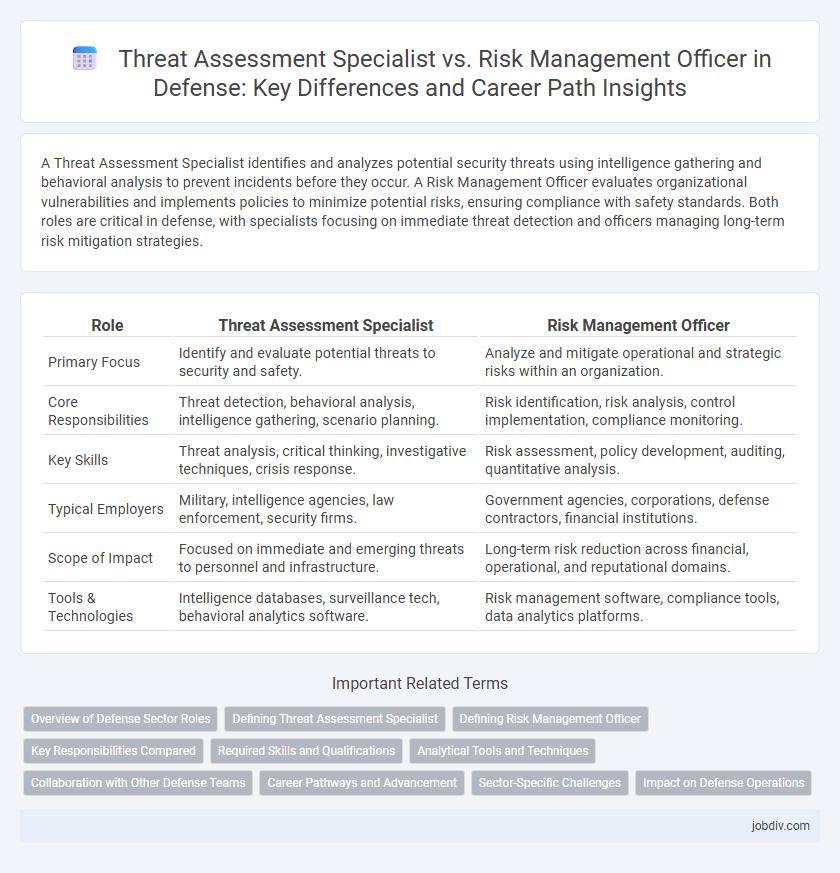A Threat Assessment Specialist identifies and analyzes potential security threats using intelligence gathering and behavioral analysis to prevent incidents before they occur. A Risk Management Officer evaluates organizational vulnerabilities and implements policies to minimize potential risks, ensuring compliance with safety standards. Both roles are critical in defense, with specialists focusing on immediate threat detection and officers managing long-term risk mitigation strategies.
Table of Comparison
| Role | Threat Assessment Specialist | Risk Management Officer |
|---|---|---|
| Primary Focus | Identify and evaluate potential threats to security and safety. | Analyze and mitigate operational and strategic risks within an organization. |
| Core Responsibilities | Threat detection, behavioral analysis, intelligence gathering, scenario planning. | Risk identification, risk analysis, control implementation, compliance monitoring. |
| Key Skills | Threat analysis, critical thinking, investigative techniques, crisis response. | Risk assessment, policy development, auditing, quantitative analysis. |
| Typical Employers | Military, intelligence agencies, law enforcement, security firms. | Government agencies, corporations, defense contractors, financial institutions. |
| Scope of Impact | Focused on immediate and emerging threats to personnel and infrastructure. | Long-term risk reduction across financial, operational, and reputational domains. |
| Tools & Technologies | Intelligence databases, surveillance tech, behavioral analytics software. | Risk management software, compliance tools, data analytics platforms. |
Overview of Defense Sector Roles
Threat Assessment Specialists analyze potential security threats by examining intelligence reports and behavioral patterns to prevent hostile actions within defense operations. Risk Management Officers oversee the identification, evaluation, and mitigation of operational risks, ensuring compliance with defense protocols and safeguarding assets. Both roles are crucial in maintaining national security, with specialists focusing on proactive threat identification and officers managing broader risk frameworks.
Defining Threat Assessment Specialist
A Threat Assessment Specialist analyzes potential security threats using advanced intelligence techniques and behavioral analysis to prevent attacks. This role focuses on identifying, evaluating, and mitigating threats specific to national security, counterterrorism, and critical infrastructure protection. Unlike a Risk Management Officer, who addresses broader organizational risks, the Threat Assessment Specialist specializes in profiling adversaries and detecting imminent dangers through data-driven threat modeling.
Defining Risk Management Officer
A Risk Management Officer systematically identifies, evaluates, and prioritizes potential threats to an organization's assets, ensuring comprehensive strategies are in place to mitigate risks effectively. Their role encompasses developing policies, conducting risk assessments, and implementing controls to safeguard operational continuity within defense environments. Unlike a Threat Assessment Specialist who focuses on analyzing specific threats, the Risk Management Officer integrates broader organizational risk considerations into strategic planning and decision-making.
Key Responsibilities Compared
Threat Assessment Specialists analyze potential security threats by evaluating intelligence reports and monitoring suspicious activities to prevent attacks, focusing on identifying, assessing, and mitigating threats in dynamic environments. Risk Management Officers develop and implement comprehensive risk management strategies, conduct risk analyses, and ensure compliance with regulatory standards to minimize organizational exposure to various operational hazards. Both roles are critical in defense, with Threat Assessment Specialists emphasizing immediate threat detection and Risk Management Officers concentrating on long-term risk reduction and policy enforcement.
Required Skills and Qualifications
Threat Assessment Specialists require expertise in behavioral analysis, intelligence gathering, and crisis intervention to identify potential security threats accurately. Risk Management Officers need strong skills in policy development, regulatory compliance, and quantitative risk evaluation to implement effective mitigation strategies. Both roles demand proficiency in cybersecurity awareness, analytical thinking, and communication skills to enhance organizational defense mechanisms.
Analytical Tools and Techniques
Threat Assessment Specialists utilize advanced behavioral analysis software and geospatial intelligence tools to identify and evaluate potential security threats, emphasizing real-time data monitoring and pattern recognition. Risk Management Officers employ quantitative risk modeling, probabilistic simulations, and regulatory compliance frameworks to assess and mitigate organizational vulnerabilities systematically. Both roles integrate data analytics platforms but diverge in focus, with specialists targeting imminent threats and officers concentrating on long-term risk control strategies.
Collaboration with Other Defense Teams
Threat Assessment Specialists collaborate closely with intelligence analysts and tactical units to identify and evaluate potential security threats, ensuring real-time data sharing enhances operational readiness. Risk Management Officers work alongside logistics, compliance, and operational teams to implement strategic policies that mitigate identified risks across defense projects. This synergy between threat evaluation and proactive risk mitigation ensures comprehensive protection frameworks within defense operations.
Career Pathways and Advancement
Threat Assessment Specialists typically advance by gaining expertise in intelligence analysis, behavioral profiling, and counterterrorism strategies, progressing to senior roles such as Chief Threat Analyst or Security Consultant. Risk Management Officers focus on identifying, evaluating, and mitigating organizational vulnerabilities, often moving into positions like Risk Director or Compliance Manager through certification in risk frameworks such as ISO 31000 or COSO. Both career paths benefit from military or law enforcement experience, with continuous professional development in cybersecurity, emergency management, and strategic planning crucial for leadership roles in defense and security sectors.
Sector-Specific Challenges
Threat Assessment Specialists focus on identifying and analyzing potential threats specific to defense sectors such as cybersecurity breaches, terrorism, and insider threats. Risk Management Officers prioritize mitigating vulnerabilities by developing strategic plans to manage operational, financial, and compliance risks inherent in defense projects and infrastructure. Sector-specific challenges include rapidly evolving technologies and geopolitical tensions that require specialized knowledge for effective threat identification and risk mitigation.
Impact on Defense Operations
Threat Assessment Specialists analyze and identify potential attack vectors, contributing crucial intelligence that shapes preemptive defense strategies. Risk Management Officers evaluate operational vulnerabilities and implement mitigation plans to minimize exposure and ensure mission continuity. Both roles synergize to enhance defense posture by balancing proactive threat identification with comprehensive risk controls.
Threat Assessment Specialist vs Risk Management Officer Infographic

 jobdiv.com
jobdiv.com